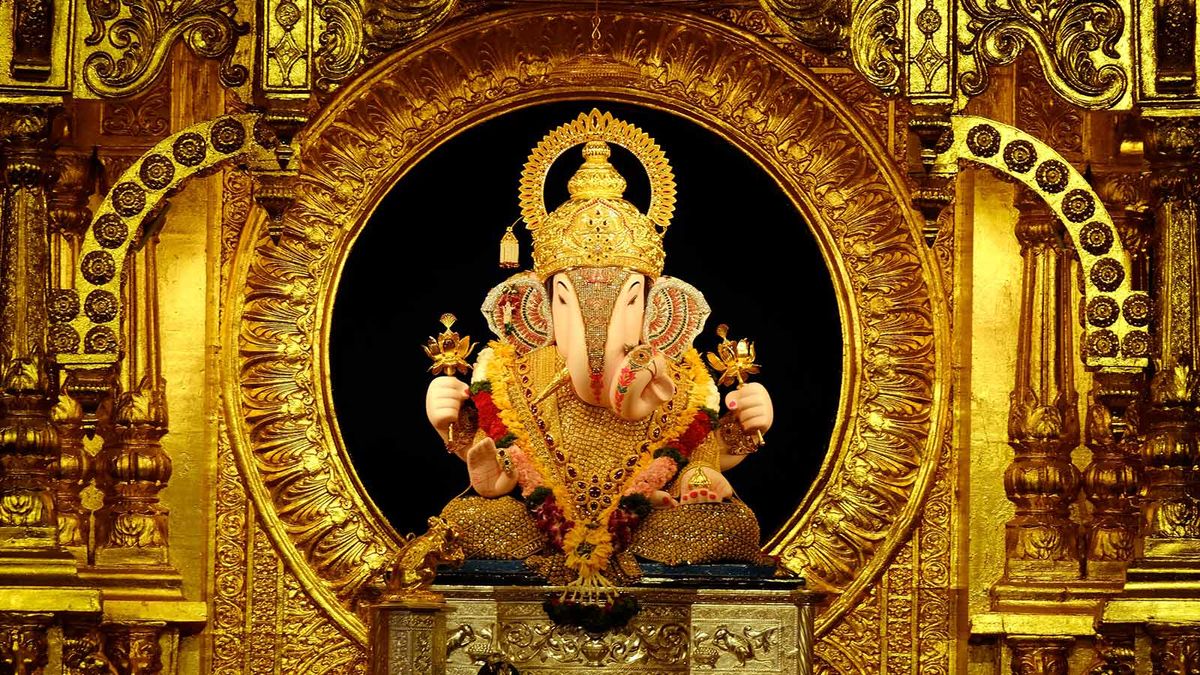Ganesh Chaturthi is a special time in Pune. That’s when the city really comes alive with devotion and celebration. Everyone’s favourite modak-eating, ladoo-loving elephant god, Ganesha rules this city and chants of ‘Ganpati Bappa Morya’ rising from every lane fills the air. For Dagdusheth Halwai—one of the oldest and the most revered mandals in the metropolis—the preparations start months in advance. This year around 2 crore devotees are expected to throng the pandal for darshan.
One man’s devotion leads to years of celebrations

The Dagadusheth Halwai Ganpati holds the rare distinction of being named after a devotee. Dagdusheth was a popular halwai (sweet maker) and a wrestler in Pune who lost his only son to the plague that gripped the city in the late 18th century. Overcome with grief Dagdusheth was totally devastated. That’s when his guru Madhavnath Maharaj asked Dagdusheth and his wife Laxmibai to build a Ganpati temple to heal themselves. Skilled artist Balaji Patole crafted the first Ganesh idol for the Shrimant Dagdusheth Halwai temple, and it was installed on February 19, 1893. When Indian nationalist leader Lokmanya Tilak floated the idea of a public celebration, Dagadusheth was among the first respondents to participate in the public installation of a Ganesh idol. Today the Ganpati pandal holds special significance for devotees and is among the five manache Ganpatis of Pune. Located in Budhwar Peth, the temple is visited by lakhs of devotees every day, especially during the 10 days of Ganesh Chaturthi.
In 1968, a new Ganesh idol was made by Karnataka’s famous sculptor Nagesh Appa Shilpi, to mark the 75th anniversary of the pandal. It’s 5.5 ft in height and is adorned with 125 kg gold ornaments made from the gold donated by devotees. During Ganesh Chaturthi the idol wears a different mukhut (crown) studded with precious stones each day. Though the idol is brought out of the temple and worshiped for 10 days in the pandal, it is never immersed (visarjan) in water. A smaller second idol is immersed in water.
What’s special this year?

For the last 75 years, the Dagdusheth Halwai Ganpati has followed a tradition of making replicas of historic temples across the country. Last year, the Panch Kedar Mandir of Uttarakhand was recreated and the year before that it was the 11th century Brihadeeswara temple of Tanjavur, Tamil Nadu. For its 131st anniversary this year, the pandal has erected a replica of the Ram Mandir in Ayodhya. The awe-inspiring structure spans an impressive 100 feet in length, 55 feet in width, and 101 feet in height. The pillars, ornate arches and the 100 feet central dome add to the magnificence. Events and inscriptions from the Ramayana adorn the pathway to the temple while replicas of Ram, Hanuman, and the vanar sena grace the entrance. “We wanted to give people a glimpse of the upcoming Ram temple in Ayodhya. It took three months and around 400 artists, sculptors, and volunteers to create the pandal. Earlier we would make the pandal in wood but now we use fibreglass as it’s environmentally-friendly and easy to dismantle and dispose,” says Mahesh Suryawanshi, treasurer, Shreemant Dagdusheth Halwai Sarvajanik Ganpati Trust.
Every year, just before the festival, the original idol gets a fresh coat of paint by the Mukhedkars (Shridhar Ambadas Mukhedkar along with his son Rajendra and grandson Anupam). They have been painting the Dagdusheth Ganesh idol for the last 50 years or so. Their endeavour is to make the idol look the same every year. Work starts 15 days prior when the old paint is scrapped off the idol and a primer is used for the body colour. The painting of the eyes (likahi) along with the eyebrows, eyelids, and pupils take the longest—and is the most important part of the painting as it gives “life” to the idol. Next comes the nakshi painting on the trunk, and finally the clothes and accessories.
Unlike Ganesh idols in Mumbai that are shrouded in mystery and visible only when you enter the pandal, the Dagdusheth Ganapti pandal is designed in such a way that devotees can have an easy darshan of the idol even from a distance. This works brilliantly for people who get overwhelmed by crowds and would like to seek blessings from outside. Production designer Aman Vidhate oversees the artistic aspect of the temple, while Waikar Bandhu does the lighting arrangements. As a sustainability initiative, the pandal distributes saplings to all devotees who perform abhishek.
Ganesh and charity

Dagdusheth Halwai is one of the richest pandals in the county, thanks to generous donors and devotees who contribute wholeheartedly. As result the trust has been able to take the festivities beyond traditional worship, into the domain of social and cultural development. “The temple trust provides food to nearly 3000 patients and caregivers every day at the Sasoon Hospital in Pune. It has also built a 59-bed NICU at the hospital and looks after many old-age homes, schools, and the education of poor children in the city. We also have a women’s kabbadi team, Suvarnayug, that has produced the former captain of Indian Kabaddi team Sumati Pujari and Dipika Joseph, the present one,” says Suryawanshi.
How to get there: The temple is centrally located in Budhvar Peth, 4 kilometres from the railway station and 12 kilometres from the airport.
Disclaimer: The views expressed in the article reflects the author(s) opinions and do not necessarily represent the views of the publisher and editor.


